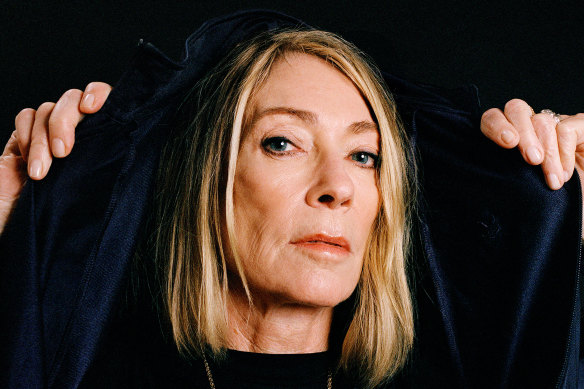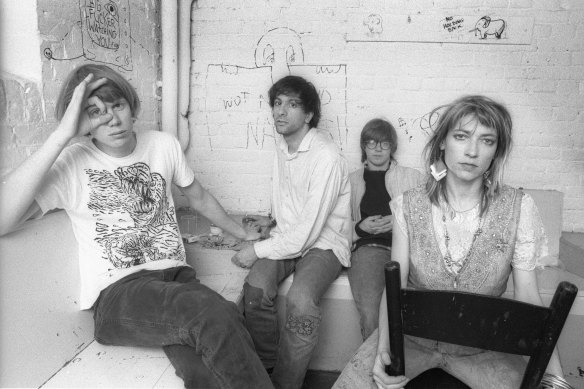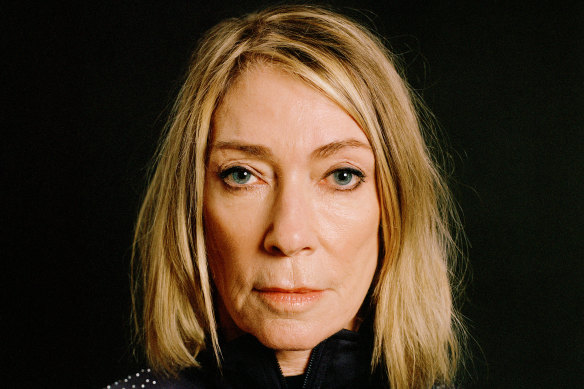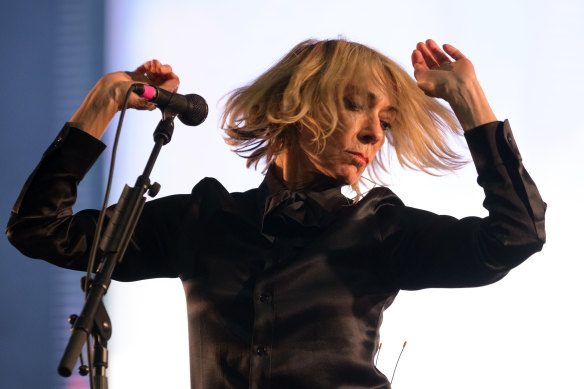Music in the ’80s belonged to Kim Gordon. At 71, she still plays hard
Long after Sonic Youth’s bitter split, the artist, writer and musician is inspiring a new generation of women.
By Jo Roberts

Kim Gordon in Los Angeles earlier this year.Credit: New York Times
The first time I saw Kim Gordon was in 1989. It was at the Collendina Hotel in Ocean Grove, a small (back then), picturesque town on Victoria’s Bellarine Peninsula. Late to the gig after a waitressing shift, I wanted to check out this New York outfit everyone was talking about. It was their first Australian tour and they’d just released a double album, Daydream Nation.
Well into their encore, and well into overdrive, Sonic Youth was tearing the place apart. At centre stage was Gordon, jumping and swaying, pummelling her bass guitar, her flailing blonde hair the centrepiece of a post-punk, no-wave maelstrom. Matching the band’s intensity, the audience was losing its collective nut. My first thought: what the hell have I just missed?
“Oh wow,” says Gordon when I remind her of the gig. Unsurprisingly, 35 years on, her memories of the tour are hazy.
“It was just big,” she recalls. “A lot of the Australian dates are glued together, but I do remember, maybe it was that first tour that we actually drove across Australia or something. Which was a good thing.”
Gordon has jammed a lot into the past 35 years, so it would be a feat to remember even half of it. Not just as a musician, but as a practising multidisciplinary artist, actor, author and writer. In short, she hasn’t stopped creating. Or inspiring. She is arguably the person most cited by women who decided to pick up a guitar or bass in the 1990s. Those who already had (um, hello) just wanted to be as cool as Kim Gordon.

Kim Gordon with Sonic Youth bandmates, from left, Thurston Moore, Lee Ranaldo and Steve Shelley in Amsterdam in 1986.Credit: Redferns
It was mainly due to Sonic Youth, the band Gordon co-founded with guitarist Thurston Moore – later her husband – in New York in 1981. Along with guitarist Lee Ranaldo and drummer Steve Shelley, they rewrote the book, the guitar tunings, the complete landscape of modern music. The band influenced other groundbreakers such as Nirvana, Pavement, My Bloody Valentine and Dinosaur Jr, and even appeared in The Simpsons (who could forget Homerpalooza?).
But in 2011, after 30 years and 16 albums, Sonic Youth was done, the collateral damage from the explosive end of Gordon and Moore’s 27-year marriage, due to Moore’s extramarital affair.
If you want to know more, read Gordon’s excellent 2015 memoir, Girl in a Band. The book opens with Sonic Youth’s final show, Moore back-slapping other band members on stage in Brazil, while the couple kept their distance. “When we came out onstage for our last show, the night was all about the boys,” she writes.
Now, for Kim Gordon, it’s not at all about the boys.

Kim Gordon does have the odd down day but only if she’s sick or jet-lagged.Credit: New York Times
Gordon is in Australia this month to promote her second solo album, The Collective. Her band is the same tight and thrilling ensemble that wowed Hobart’s Dark Mofo festival in 2022 – Madi Vogt on drums, Sarah Register on guitar and keys and Camilla Charlesworth on bass and keyboard.
The Collective is a deliciously dark, textural and sinister collection of songs written by Gordon. Her voice is, as ever, the most distinctive instrument, layered atop a bed of crunching electronic beats and stabs from producer Justin Raisen (John Cale, Yeah Yeah Yeahs, Santigold). Raisen also produced Gordon’s first solo album, 2019’s No Home Record.
Both were albums Gordon, 71, had no intention of making. She has always considered herself first and foremost a visual and conceptual artist; she went to New York in 1980 to forge a career as an artist, after all.
“Well, honestly, I really had no desire to make a record or work with a producer,” says Gordon, who now lives in Los Angeles.
“I have this duo, Body/Head, with Bill Nace. We’ve been working together since 2013 or something, and I really like that. It’s just very free, it’s super fun to work with Bill. So, I have that musical outlet. I’m not really a part of the music scene in LA. I just always thought, well, I have my art career, my art practice.”
Take 7: The answers according to Kim Gordon
- Worst habit? Procrastinating but I also see it as an asset. But looking at my phone as a means of procrastinating is the worst.
- Greatest fear? Not to have a new idea.
- The line that stayed with you? It’s showtime! (All That Jazz)
- Biggest regret? Not to have enjoyed more of a feckless youth.
- Favourite book? It would take a long time to answer this so anything by Charles Schulz.
- The artwork/song you wish was yours? Lucio Fontana’s cut paintings.
- If you could time travel, where would you go? New York in the ’50s/’60s.
But as is often the case with Gordon, opportunities find her. She met Raisen through his brother and “he kept sending me stuff and I was like, ‘No, no’. And then finally he sent something, I said, ‘OK, I could do something on this’.
“He has a home garage studio, basically, which a lot of people in LA do. And I laid down some vocals … and he put them to this very trashy drum beat. And he sent it to me and I was like, ‘Oh, he gets my sensibility’. And so I went back and I did some more vocals and put guitar down, and that’s the song that became Murdered Out [from No Home Record].”
Both albums have earned high critical praise, but the stepped-up industrial dissonance of The Collective has resonated most strongly, particularly the songs BYE BYE and I’m a Man. The videos for each song feature Gordon’s daughter, Coco Gordon Moore, a poet, actor and artist in her own right. Coco, 30, has also directed the clip for a new single, ECRP.
The album’s success has meant a heavy touring schedule through the US, UK and Europe since the album’s release in March.
When I speak to Gordon, she’s in Poland for the Open’er Festival in Gdynia. “It seems like a nice festival,” she says. “They have real toilets backstage, which is an anomaly at a festival. Glastonbury still has shit toilets. I really am not crazy about festivals. It’s not the best place to actually hear music.”
Tomorrow it’s Prague and then on to Berlin for the final European show, where she is looking forward to spending a few days with Coco, who is flying in from New York. “Then I’m going to Latvia for a project, so I’m going to fly from there to Australia,” says Gordon, declining to elaborate on the Latvian project.

From Kim Gordon’s Object of Projection exhibition at The Substation in Newport. Credit: Machiko Abe
She is also planning a new art exhibition in Avignon, France next year. And while she’s in Melbourne, she will speak at an “in conversation” event at the Substation Gallery in Newport for her current exhibition, Object of Projection, a collection of photographic and mixed media pieces and video works. “That’s my day off,” she says drily.
Does she ever have days when she just lies on the couch and watches bad TV?
“Yeah, sure,” she replies. “Usually if I’m sick or jet-lagged.”
Most people would say that doesn’t count. But Kim Gordon isn’t most people.
Gordon’s friend and fellow trailblazer, Kathleen Hanna of Bikini Kill, likened Gordon’s need to constantly make art to a shark that must keep swimming to survive.

Kim Gordon performing in Paris on June 1.Credit: Getty Images
“It’s just who she is. What Kim’s doing is totally, absolutely normal,” says Hanna. “What’s not normal is when women or people who are marginalised in other ways have stopped making art for reasons having to do with ageism or sexism. We’re not witnessing a miracle, we’re witnessing what happens when the thing that’s supposed to happen is just allowed to happen.”
A few days after I speak to Gordon, scrolling through the socials, I see a friend has been watching her and her band on stage in Berlin at the Festsaal Kreuzberg. Her one-line review says it all: “She doesn’t need those guys any more.”
Kim Gordon performs at Volume, Art Gallery of NSW, on July 18 and 19, Brisbane Powerhouse on July 21, and the Northcote Theatre in Melbourne on July 24 (sold out) and 25. She speaks at the Substation Gallery in Newport on July 23. The Collective is out now through Matador/Remote Control Records.